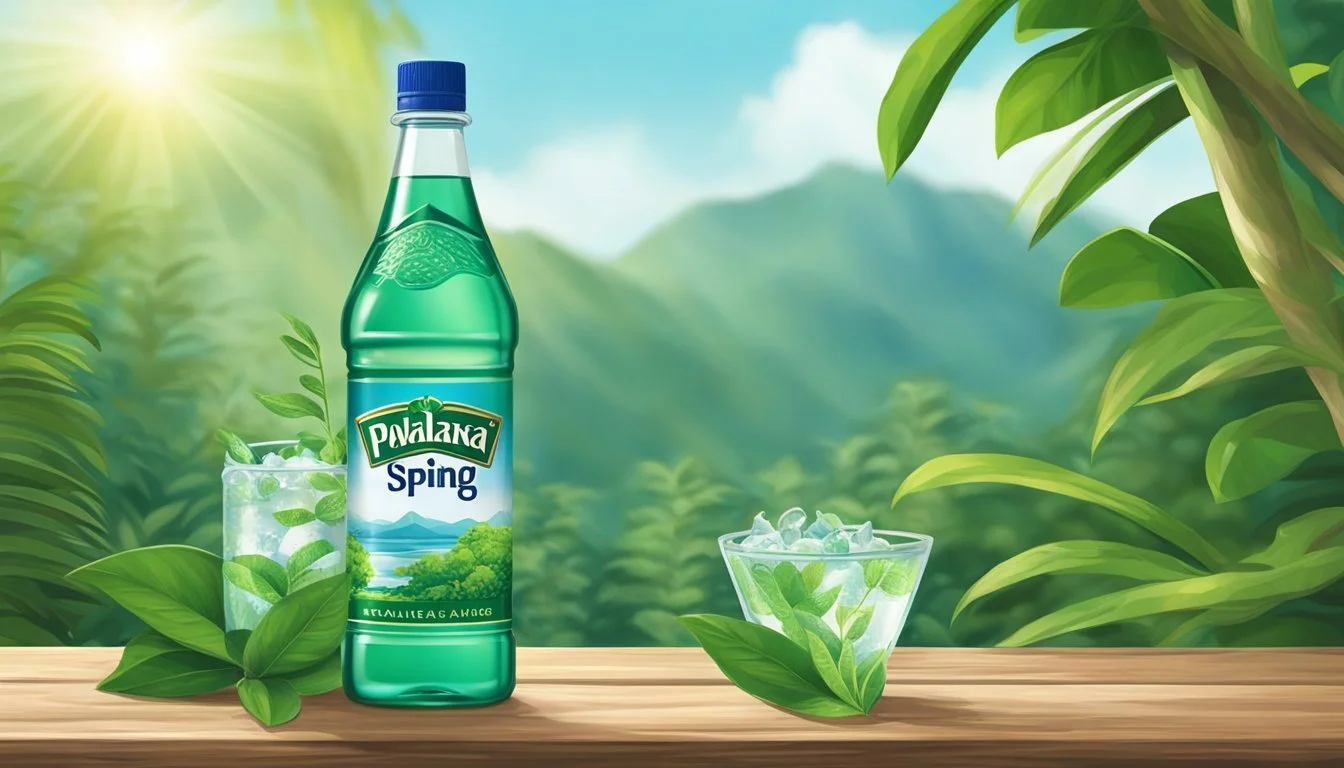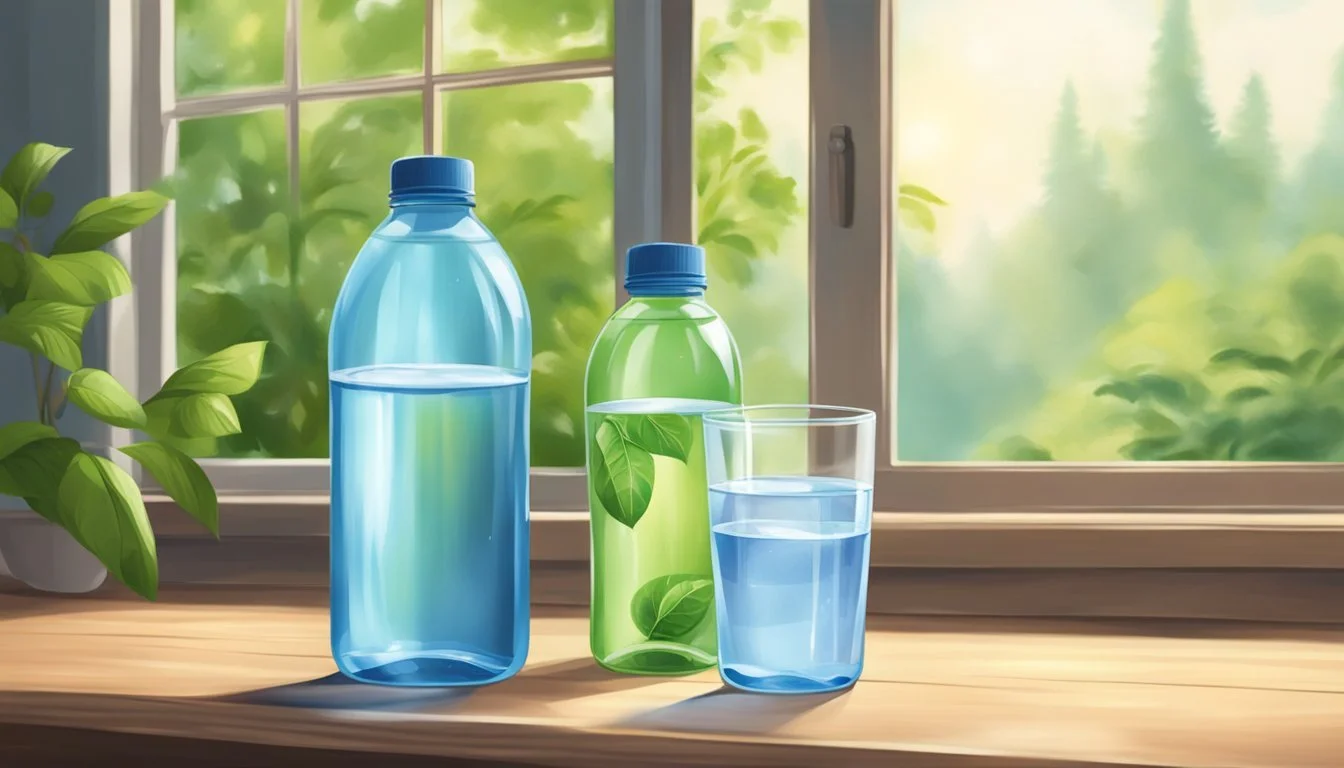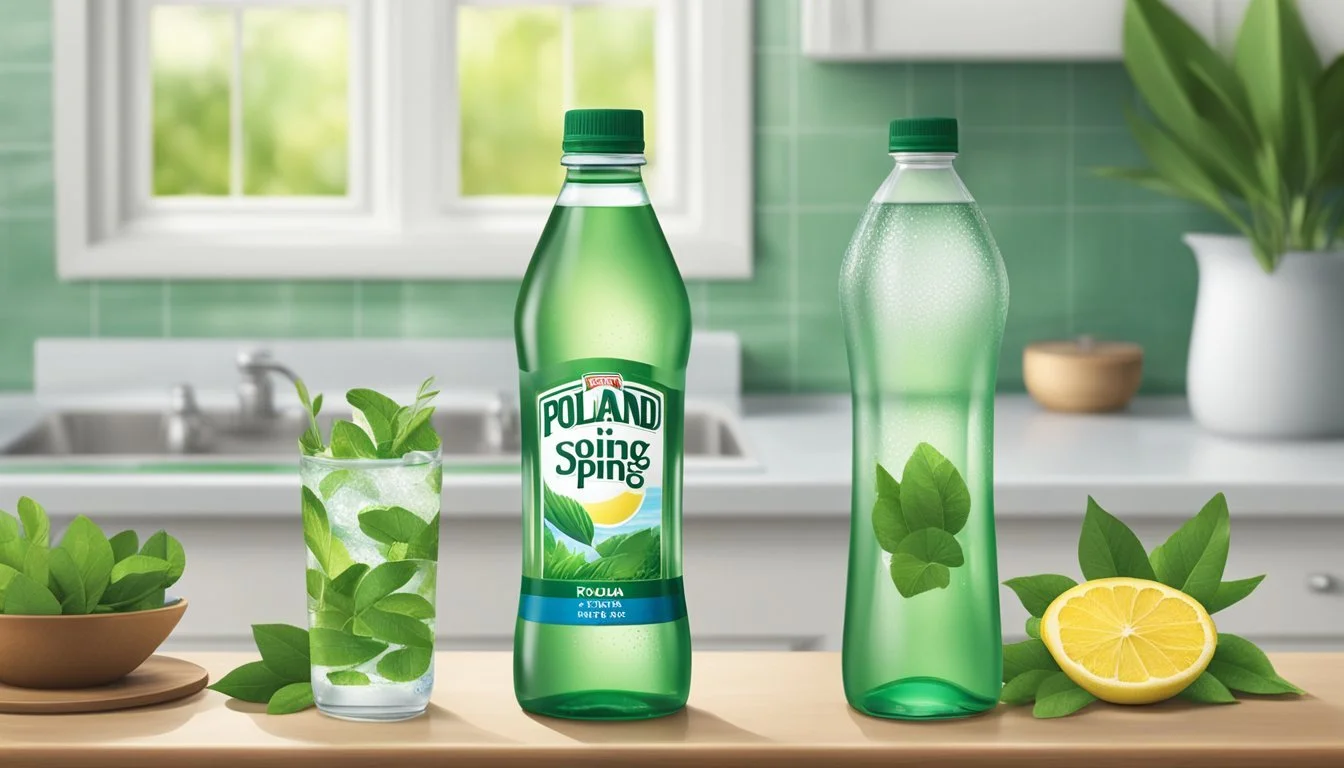Poland Spring vs. Waiakea
Comparing Premium Bottled Waters
Choosing the right bottled water can be a daunting task, but two brands often highlighted are Poland Spring and Waiakea. Poland Spring, sourced from various springs in Maine, prides itself on its natural taste and longstanding reputation. Comparatively, Waiakea originates from a volcanic well in Hawaii, boasting a naturally alkaline pH and a unique mineral composition.
If you're looking for water with naturally occurring electrolytes and a higher pH level, Waiakea might be the better choice. However, Poland Spring offers a more traditional taste, making it a favorite for those who prefer classic spring water without the unique mineral profile found in Waiakea.
Exploring the differences in taste, source, and mineral content between Poland Spring and Waiakea can help consumers make an informed decision on which bottled water fits their lifestyle. Whether you prioritize the purity and alkalinity of Waiakea or the familiarity and availability of Poland Spring, understanding their qualities ensures you choose the best option for your hydration needs.
Understanding Bottled Water
Bottled water comes in many forms, each with its characteristics and standards. Regulatory measures and market trends also significantly impact consumer choices and product offerings.
Types of Bottled Water
Spring Water: Sourced directly from natural springs, spring water is often marketed for its purity and mineral content. Notable brands include Poland Spring, which claims to offer crisp, fresh-tasting water.
Purified Water: Purified water includes tap and underground water processed to remove impurities. This category ensures a consistent quality level and includes brands like Aquafina and Dasani.
Alkaline Water: Alkaline water has a higher pH level than regular water, often enriched with minerals like calcium and magnesium. Waiakea, for instance, offers naturally alkaline water sourced from Hawaiian volcanic wells.
Mineral Water: Contains dissolved minerals acquired from geological sources. It is often favored for its taste and potential health benefits. Notable brands in this category include Perrier and San Pellegrino.
Regulatory Framework
Bottled water is regulated to ensure safety and quality. In the United States, the Food and Drug Administration (FDA) oversees bottled water standards, requiring compliance with specific health and safety regulations.
For spring water, standards ensure it is collected from a natural source without additional treatment. Purified water must meet rigorous purification processes to ensure contaminants are removed effectively. Alkaline and mineral waters must maintain their mineral content and pH levels consistently.
These regulations help maintain consumer trust and establish a baseline for quality across various bottled water types.
Market Dynamics
The bottled water market is influenced by consumer preferences, environmental concerns, and marketing strategies. Brands like Waiakea highlight sustainability, being certified Carbon Neutral and donating a portion of their profits to global nonprofits.
Poland Spring appeals to a budget-conscious demographic with its economical pricing, despite controversies surrounding its source and plastic use. Awareness of microplastics and synthetic chemicals in bottled waters, like Poland Spring, affects market perception and consumer choices.
Brand reputation, environmental impact, and water quality are critical factors in shaping the bottled water industry's dynamics.
Assessing Water Quality
When comparing Poland Spring and Waiakea, key aspects to consider include water quality indicators, adherence to safety standards, and mineral content. This helps to determine which brand provides a superior product.
Quality Indicators
Poland Spring and Waiakea have distinct water quality indicators that set them apart. Poland Spring sources its water from natural springs in Maine, ensuring a supply with consistent purity and taste.
Waiakea, on the other hand, originates from Hawaiian volcanic rock aquifers. The volcanic filtration process enriches Waiakea with natural electrolytes and minerals, contributing to its unique taste. Both brands utilize thorough purification processes, with Poland Spring focusing on maintaining natural purity and Waiakea leveraging volcanic filtration.
Safety Standards
Both brands adhere to stringent safety standards set by the Environmental Protection Agency (EPA). Poland Spring complies with federal and state regulations to ensure the absence of harmful contaminants. Regular testing is conducted to meet these criteria.
Waiakea also meets EPA regulations and exceeds them by voluntarily adhering to higher standards for purity and safety. They emphasize their commitment to sustainability and full transparency.
Mineral Content Analysis
Poland Spring and Waiakea offer different mineral profiles reflective of their sources. Poland Spring is known for its natural mineral composition, including calcium, magnesium, and sodium. This gives it a refreshing taste, typical of natural spring water.
Waiakea water is rich in minerals due to the volcanic filtration, including higher levels of silica, calcium, and magnesium. This contributes to a silky mouthfeel and can be beneficial for those seeking water with higher mineral content. Both brands provide detailed mineral content information, allowing consumers to make informed choices based on their preferences.
Environmental and Health Impact
Both Poland Spring and Waiakea claim to be environmentally conscious and promote health benefits. Examining these aspects can help determine which brand aligns better with eco-friendly practices and provides advantageous health outcomes.
Environmental Footprint
Waiakea sources its water sustainably from the Waiakea springs and bottles it at a facility powered by 100% renewable energy. The company uses high-grade, 100% recycled plastic for their bottles, reducing their environmental impact significantly. Waiakea's commitment extends to reforestation projects and clean water initiatives in developing countries.
Poland Spring, part of the Nestlé Waters North America family, also focuses on sustainability. The company has increased the use of recycled plastic in their bottles, aiming to make all their packaging recyclable by 2025. They have various water stewardship programs to protect natural water sources.
The main difference lies in Waiakea's use of 100% renewable energy and 100% recycled packaging, compared to Poland Spring's ongoing transition towards these goals. Both companies contribute positively, but Waiakea currently leads in minimizing its environmental footprint.
Health Implications
Waiakea water boasts an alkaline pH level around 8.2, which some consumers believe can help neutralize acidity in the body and improve hydration. It is naturally filtered through volcanic rock, enriching it with minerals like silica, magnesium, and calcium. The water is also free from harmful chemicals like BPA and PFAS, ensuring safety for consumers.
Poland Spring water is sourced from various springs in Maine and is known for its clean, crisp taste. It has a pH level closer to neutral, around 7.2, and contains naturally occurring minerals. Poland Spring’s packaging is also BPA-free, which minimizes the risk of chemical leaching.
While both brands offer safe and hydrating water options, Waiakea's added minerals and higher pH level provide distinct health benefits for those seeking alkaline water. Poland Spring remains a reliable option for those preferring neutral pH water with natural mineral content.
Brand Profiles
Poland Spring and Waiakea are two distinct brands in the bottled water industry, each with unique characteristics and values. This section explores their histories, source locations, and defining features.
Poland Spring: Brand Overview
Poland Spring is a long-standing brand known for its natural spring water sourced from multiple locations in Maine, USA. Established in 1845, it is recognized for its refreshing taste and consistency. This brand is owned by Nestlé, a major player in the bottled water market.
Poland Spring water undergoes a stringent filtration process to remove impurities while maintaining essential minerals. It prides itself on providing a consistently clean and crisp taste.
The brand also focuses on sustainability. They use recycled PET plastic in their bottles and aim to significantly reduce their environmental footprint.
Waiakea: Brand Overview
Waiakea water, originating from Hawaii, is noted for its volcanic filtration process. This natural filtration through porous lava rock gives it a unique mineral composition and an alkaline pH level ranging from 7.6 to 8.2. These attributes are believed to offer beneficial properties.
Founded in 2012, Waiakea emphasizes environmental and social responsibility. It was the first U.S. bottled water to achieve CarbonNeutral certification. Additionally, they donate over 5% of their revenue to community projects in Hawaii and beyond.
Waiakea bottles are made using 100% recycled materials, reinforcing their commitment to reducing plastic waste and promoting sustainability in the bottled water industry.
Source and Extraction
The source and extraction methods of bottled water play a crucial role in determining its quality and taste. Comparing Poland Spring and Waiakea reveals notable differences in both aspects.
Water Sources Compared
Poland Spring sources its water from multiple natural springs located in Maine. These include Poland Spring, Garden Spring, and other nearby sources. Notably, these springs are renowned for their historical significance and have been tapped since 1845. The water originates from groundwater that naturally percolates through sandy and gravelly soil, which helps in filtration.
Waiakea sources its water from the Mauna Loa volcano in Hawaii. This pristine environment provides water that is naturally filtered through volcanic rock. This unique filtration process enriches the water with minerals like silica, calcium, and magnesium. Unlike many other waters, Waiakea's source is sustainable, with a renewable aquifer that has an annual recharge rate of 393 million gallons.
Extraction Processes
Poland Spring employs minimal processing to preserve the natural quality of its water. The extraction involves collecting the water directly from the springs. It is then transported to a plant where it undergoes filtration and sterilization to ensure it meets safety standards. The company follows strict protocols to protect their water sources, including maintaining forested buffer areas around springs.
Waiakea uses a different extraction process that leans heavily on sustainability. Water is collected from the aquifer through an environmentally friendly method that minimizes impact. The company emphasizes responsible sourcing and uses renewable energy for its extraction and bottling processes. This approach helps reduce the carbon footprint, making Waiakea a more eco-conscious choice.
Both brands highlight the importance of preserving natural resources while ensuring the quality of the water remains uncompromised. Addressing these factors helps consumers make informed choices based on the source and extraction methods of their bottled water.
Taste and Composition
Poland Spring and Waiakea offer distinct experiences when it comes to taste and mineral content. Understanding these differences can help consumers choose the best option according to their preferences.
Taste Profiles
Poland Spring water is known for its clean and crisp taste. It has a smooth mouthfeel with a natural freshness that many consumers find appealing. There is no noticeable aftertaste, making it a popular choice for those who prefer a neutral palette.
Waiakea, sourced from Hawaii, presents a slightly silky texture with a hint of sweetness. Its volcanic origin infuses the water with unique mineral content that results in a smooth, refreshing finish. The aftertaste is gentle, leaving a subtle yet distinct impression that differentiates it from other brands.
Nutrient Composition
Poland Spring focuses on purity, with low dissolved solids. It contains essential minerals such as calcium and magnesium but in lower concentrations compared to other brands. This results in a lighter taste profile and is preferred by those looking for basic hydration without additional flavors.
Waiakea boasts a higher mineral content due to its volcanic source. It is enriched with electrolytes like potassium and magnesium, adding to its health benefits. The presence of silica provides a soft mouthfeel, contributing to its unique taste. The balanced interplay of these minerals offers not only a refreshing experience but also essential nutrients that support overall well-being.
Treatment and Purity
Poland Spring and Waiakea offer distinct approaches to water treatment and purity, employing different techniques and standards to ensure the quality and safety of their products.
Filtration Techniques
Poland Spring uses a multi-step filtration process to purify its water, emphasizing natural spring sources. The process includes sand filtration, carbon filtration, and micron filtration to remove impurities.
Additionally, they use ozone as a disinfectant rather than chlorine to ensure the water is safe without altering its taste. This method helps maintain the natural mineral content that gives Poland Spring its unique flavor.
In contrast, Waiakea’s filtration process involves volcanic rock filtration, naturally occurring as the water passes through porous volcanic rock before being collected. This natural filtration adds essential minerals like calcium, magnesium, and silica, enhancing the water’s taste and health benefits.
Purity Levels
Poland Spring prides itself on sourcing its water from springs in Maine, which undergoes stringent quality checks to maintain high purity levels. They regularly test for contaminants such as fluoride and PFAS to comply with safety standards, ensuring no harmful substances are present.
Waiakea emphasizes purity by using a natural filtration process which ensures the water is free from contaminants. It employs ultraviolet light disinfection to eliminate any potential microbial contamination.
Moreover, the volcanic filtration provides additional natural purification, ensuring robust purity without relying heavily on added chemicals or treatments. This method results in a crisp, clean taste that reflects the water's natural origins.
Packaging and Convenience
Packaging and convenience are crucial factors when choosing between Poland Spring and Waiakea. Each brand offers distinct approaches to bottle materials and ease of access, influencing both the user experience and environmental impact.
Bottle Materials
Poland Spring primarily uses plastic bottles, including a significant percentage of recycled plastic in their packaging. This choice helps reduce environmental waste while maintaining convenience for the user. Their plastic bottles are lightweight and easy to carry.
In contrast, Waiakea offers a mix of plastic and glass bottles. They focus on eco-friendly options, using recycled plastic and emphasizing sustainability. The glass bottles provide a premium feel but are heavier and less convenient for on-the-go scenarios.
Brand Material Eco-Friendly Features Poland Spring Plastic Recycled plastic bottles available Waiakea Plastic, Glass Recycled plastic, carbon-neutral
Ease of Access
Poland Spring bottles are widely available across various retail outlets, adding to their convenience. The screw-top design makes them easy to open and reseal, suitable for everyday use and outdoor activities.
Waiakea, while available in select stores, often requires purchase from specialized retailers or online. Their packaging focuses on sustainability, sometimes incorporating designs that are more complex to open. The inclusion of glass bottles makes them less practical for travel but adds a touch of luxury for home or office settings.
Key Points:
Poland Spring: Easy to carry and widely available.
Waiakea: May require specialized purchase, offers premium feel but less convenient for travel.
Comparative Analysis
Poland Spring and Waiakea are two distinct brands in the bottled water market, each with unique attributes and consumer perceptions. This section examines their qualities in terms of source, taste, and overall brand trust.
Direct Comparison
Poland Spring originates from multiple springs in Maine. Its water is classified as spring water, meeting FDA and EPA standards. The filtration process is minimal, retaining natural minerals for a crisp taste.
Waiakea, in contrast, is sourced from a Hawaiian volcano, adding a unique mineral composition. The water passes through porous volcanic rock, enriching it with electrolytes like calcium, magnesium, and potassium. Waiakea highlights its alkaline pH of 8.2 and its eco-friendly packaging.
Aspect Poland Spring Waiakea Source Multiple springs in Maine Volcanic rock in Hawaii Process Minimal filtration Natural filtration through lava Mineral Content Moderate High in electrolytes pH Level ~7.0 Alkaline pH 8.2
Consumer Perceptions
Poland Spring enjoys a strong reputation in the northeastern United States. Many consumers trust its consistent quality and natural flavor, which has been a household staple for years.
Waiakea is perceived as a premium brand. Consumers appreciate its unique volcanic source and the brand's focus on sustainability practices, like using recycled bottles and supporting Hawaiian conservation efforts.
Some consumers feel that Waiakea’s high mineral content provides additional health benefits, while others prefer the traditional, clean taste of Poland Spring. Both brands are well-regarded, but their distinct attributes attract different consumer bases.
Conclusion
When evaluating Poland Spring and Waiakea bottled waters, several key aspects arise. Poland Spring, known for its long-standing presence in the bottled water market, derives its water from natural springs. This brand is often favored for its balanced mineral content and wide availability.
Waiakea sets itself apart with a naturally high alkaline pH of 8.8, making it unique in neutralizing body acidity. The brand's commitment to sustainability is noteworthy, including its Carbon Neutral certification and contributions to nonprofit organizations.
Taste is subjective but both brands offer distinct profiles. Poland Spring water features a more traditional mineral taste, while Waiakea promotes a cleaner, crisper flavor due to its volcanic filtration process.
Sustainability remains a significant differentiator. With Waiakea's emphasis on eco-friendly practices, it appeals to environmentally conscious consumers. Poland Spring, while popular, does not prioritize sustainability to the same degree.
Cost may also influence decisions. Poland Spring is generally more cost-effective, making it accessible for everyday consumption, whereas Waiakea's premium price reflects its unique properties and sustainability efforts.
Consider these factors:
Source: Natural springs vs. volcanic filtration
pH Level: Balanced vs. high alkaline
Taste: Traditional mineral vs. crisp and clean
Sustainability: Standard practices vs. robust eco-friendly initiatives
Price: Affordable vs. premium
Consumers' preferences will ultimately guide their choice between these two brands.
More About Poland Spring
Acqua Panna vs Poland Spring: Which Bottled Water is Better?
Boxed Water vs Poland Spring: Which Bottled Water is Better?
Core Hydration vs Poland Spring: Which Bottled Water is Better?
Ice Mountain vs Poland Spring: Which Bottled Water is Better?
Icelandic Glacial vs Poland Spring: Which Bottled Water is Better?
Mountain Valley Spring Water vs Poland Spring: Which Bottled Water is Better?
Nestle Pure Life vs Poland Spring: Which Bottled Water is Better?
Poland Spring vs Aqua Carpatica: Which Bottled Water is Better?
Poland Spring vs Cascade Mountain: Which Bottled Water is Better?
Poland Spring vs Castle Rock: Which Bottled Water is Better?
Poland Spring vs Crystal Geyser: Which Bottled Water is Better?
Poland Spring vs Crystal Lake: Which Bottled Water is Better?
Poland Spring vs Essence pH10: Which Bottled Water is Better?
Poland Spring vs Hawaii Volcanic: Which Bottled Water is Better?
Poland Spring vs Hawaiian Springs: Which Bottled Water is Better?
Poland Spring vs Kirkland Signature: Which Bottled Water is Better?
Poland Spring vs Liquid Death: Which Bottled Water is Better?
Poland Spring vs Proud Source: Which Bottled Water is Better?
Poland Spring vs Purely Sedona: Which Bottled Water is Better?
Poland Spring vs Richard's Rainwater: Which Bottled Water is Better?
Poland Spring vs San Pellegrino: Which Bottled Water is Better?
Poland Spring vs Simple Truth: Which Bottled Water is Better?
Poland Spring vs Solan de Cabras: Which Bottled Water is Better?
Poland Spring vs Talking Rain AQA: Which Bottled Water is Better?
Poland Spring vs Weird Water: Which Bottled Water is Better?
Poland Spring vs Whole Foods 365: Which Bottled Water is Better?
Poland Spring vs Whole Foods Italian Still Mineral water: Which Bottled Water is Better?
Poland Spring vs Zephyrhills: Which Bottled Water is Better?
More About Waiakea
Icelandic Glacial vs Waiakea: Which Bottled Water is Better?
Mountain Valley Spring Water vs Waiakea: Which Bottled Water is Better?
Waiakea vs Kirkland Signature: Which Bottled Water is Better?
Waiakea vs Richard's Rainwater: Which Bottled Water is Better?
Waiakea vs Whole Foods Italian Still Mineral water: Which Bottled Water is Better?










